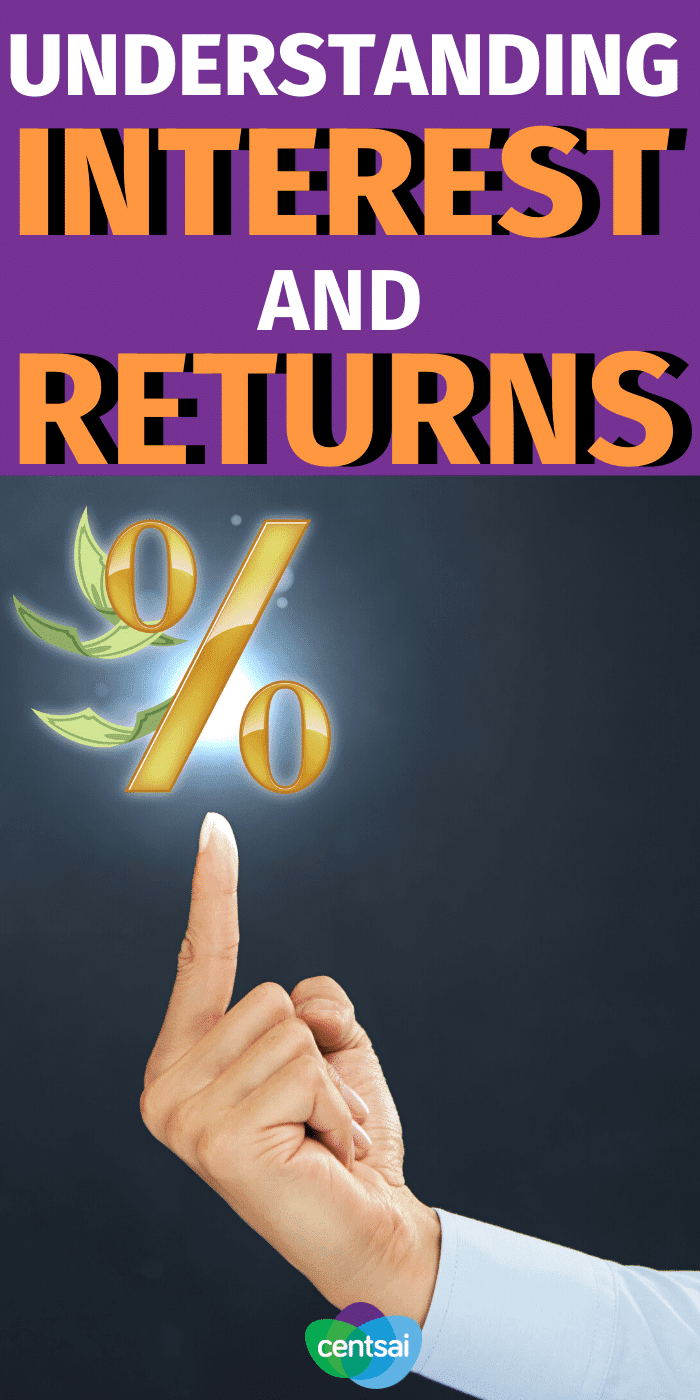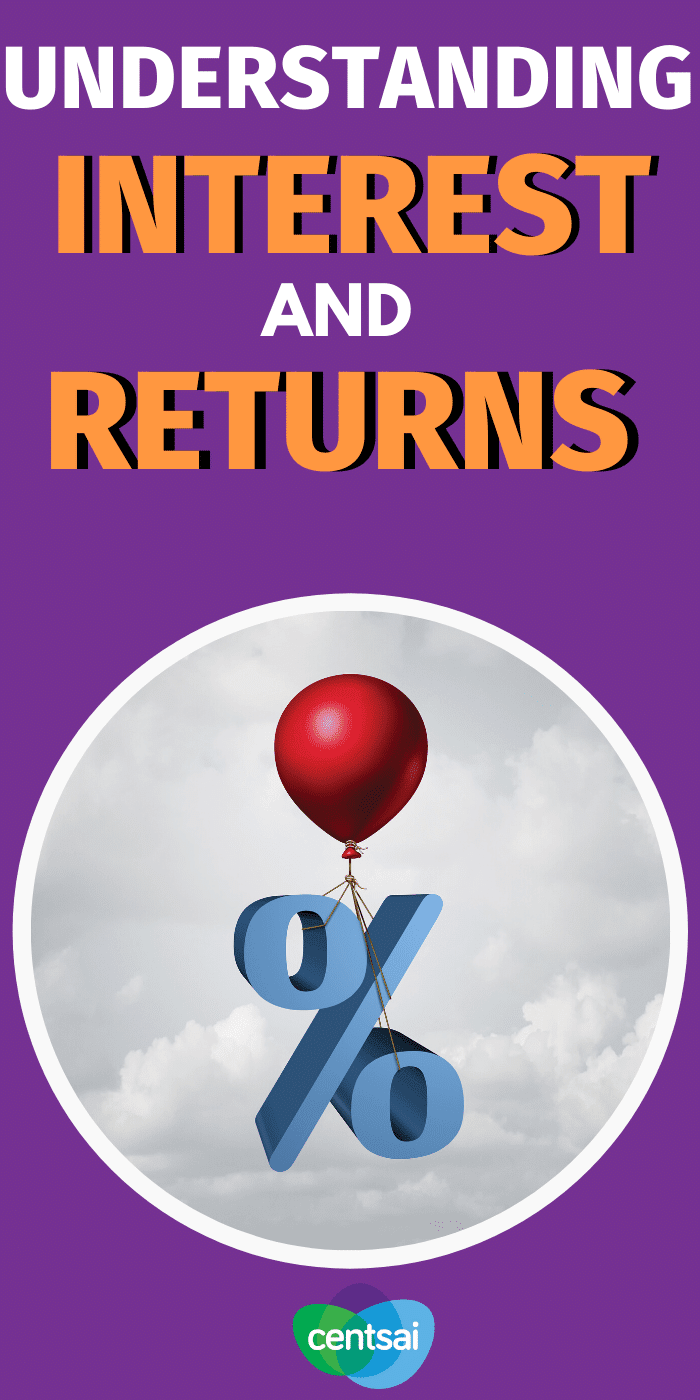There are a variety of terms describing components or aspects of investment performance. The type and form of return can make a difference. For example, long-term capital gains are taxed differently than interest income. Understanding the terminology used with different forms of interest and returns will help you understand how your investments work and what they are doing.
Interest
Some investments earn interest. Savings accounts, money market accounts, and some checking accounts earn interest. Interest is compensation for the use of your funds.
Bonds also earn interest. There is a relationship between an investment’s risk and the amount of interest it pays. The greater the investment’s risk, the greater interest it tends to pay. Savings accounts and money market accounts are low risk; they pay interest at low rates.
Bonds have varying degrees of risk. U.S. savings bonds have very little risk and pay low interest. Some corporate bonds may be quite risky and therefore need to pay significant interest in order to induce investors to accept that risk.
Interest, whether earned or paid, is generally expressed as an annual rate. For example, a mortgage might have a rate of 4 percent per year. Interest can be calculated in different ways.
Understanding Simple Interest
Simple interest is calculated off of your original investment each period for interest earned. For example, if you invest $1,000 at 6 percent simple interest, you will earn $60 each year. Simple interest is always based off of the principal amount.
Understanding Compound Interest
The only difference between simple interest and compound interest is how it is calculated. Compound interest not only pays on the principal but also on the accumulated prior interest. For example, you invest $1,000 at 6 percent compound interest.
You earn $60 the first year, just like you did in the simple interest example. But for the next year, you earn interest on your original $1,000 (or principal) and also on the $60 accumulated prior interest. In your second year, you earn $63.60 in interest.
Compound interest compounds your return because you are getting return on not only your original principal, but you are also getting return on your earnings.
That’s the compounding in compound interest.
In simple interest, you earn the percentage rate on your principal each year. In compound interest, your principal increases each year by the prior year’s interest. Instead of earning the same amount every year, every year you earn more than you did the year before.
Some investments earn simple interest; some compound. It is important to know which type of interest you are earning. It’s not that simple interest is bad; it’s that you will need to take that interest and invest it to produce a return off of your prior earnings.
Dividends
Some investments pay dividends. Some stocks pay dividends. Not all stocks do.
Dividends are a return to the shareholders. Some companies take the returns and reinvest them into the company to grow in subsequent years. Other companies may not do so for a variety of reasons. They may not have the ability to grow significantly.
Utilities are the classic example of a company with finite growth potential. Utilities have traditionally paid strong dividends to make their total return on par with other stock investments. Companies may not have the opportunity to invest all of their earnings or may prefer to return a portion of their earnings to shareholders.
Insurance dividends aren’t the same as stock dividends. Dividends paid by mutual insurance companies to their stockholders are a return of excess premium. You wouldn’t buy an insurance policy for the dividend, and as a return of excess premium an insurance dividend is not an investment return.
Appreciation
Most people are familiar with depreciation as a term. Depreciation is the opposite of appreciation. We all know when you purchase a new car it depreciates significantly before you drive it off of the lot. But what does that mean?
An asset depreciates when it decreases in value across time. The new car example is one we are all familiar with because the amount of depreciation is significant in an instant of time. You buy the car, and it’s worth about 20 percent less by the time you get off the car lot. That’s a lot of loss in a short time. Why does that happen?
Some people love new cars. As soon as your car becomes yours, it can no longer be sold as new. It is now, from a marketing standpoint, a used car. No one will give you a new car price for your used car. You will need to drop the price significantly if you want to induce someone else to purchase your new-to-you used car.
Appreciation works the opposite. Some assets gain value across time. Typically real estate gains value across time. When you purchase a house, you expect you will be able to sell the house for significantly more money at some future time.
People purchase stocks and other appreciable assets with the same expectation. They purchase a stock expecting to be able to sell that stock for more than they paid for it at some point in the future. If you buy a stock for $100 per share and a few years down the road your shares are worth $120 each, that $20 of increase in value is appreciation. Your shares have appreciated in value.
Capital Gains
Capital gains is a tax-related term. When we speak of capital gains, we are really talking about the tax treatment of an investment gain.
If you sell an asset for more than you paid for it, you realize that gain.
Let’s go back to our stock example above. You had purchased the investment for $100 per share and it’s now worth $120 per share. Let’s say you have 100 shares. If you sell your 100 shares, you will realize a gain of $20 per share or $2,000 total. This is realized appreciation, before you sold them you had appreciation, but it wasn’t realized until you locked it in by selling the shares. If you have no costs or other exclusions, you would recognize the entire gain for tax purposes; that would be your capital gain. That’s not generally the case.
Typically, you will have some brokerage charges or some other costs depending on what you sell. After deducting those expenses that are excluded from taxation, your gain recognized for tax purposes is your capital gain.
Sometimes you don’t have to pay the tax at this point, such as on an asset held in a tax qualified plan. It’s still a capital gain; it’s just not taxable at this point.
Short-Term and Long-Term Gains
We differentiate between short-term and long-term gains for tax purposes. When you sell an asset that you have held for a year or less, the gain or loss is generally short-term. When you sell an asset that you have held for more than one year, the gain or loss is generally long-term. The classification affects how the gain or loss is treated for taxes.
Short-term gains are taxed as ordinary income, meaning they are added to your regular income and taxed at your highest rate. Long-term gains receive favorable tax treatment.
Mutual funds typically report long-term gains to shareholders each year as long-term gains so they can be handled appropriately for tax treatment. The fund companies will generally combine short-term gains with dividends and report those together, as the short-term gains don’t enjoy favorable tax treatment.
Yield
An investment’s yield is simply what it pays out — its distributions expressed as a rate. A bond that pays 6 percent interest would generally be thought of as having a yield of 6 percent. Likewise, dividends can also be expressed as a percentage of your investment to determine a yield.
Yield may be important in some specific situations, such as structuring investments to produce ongoing income to live on. Similar to how a field yields a crop without depleting the field, investments can also produce a yield.
Total Return
In most cases, this is what people really want to know — their total return. Total return is the sum of all return components. Some can be positive (hopefully all are), but that’s not always the case. You might have a bond which has a positive yield in that it produces interest income, but has a loss in principal value due to market conditions. Your total return could be positive or negative depending on the magnitude of the loss.
Volatility impacts return, especially in the short-term. Stocks are volatile, and are likely to have down years as well as up years. Volatility becomes less of a factor in the long-term, when you are looking at the combination of positive and negative impacts of volatility.
Understanding Investment Interest and Returns: The Bottom Line
The type of return we receive from investments matters. It matters because some income is immediately usable and some, such as appreciation, is deferred. It matters because of tax treatment. And it matters because when we refer to an investment producing an income it doesn’t produce or use a term in a nonsensical manner it leads to the impression that we don’t understand our investments.
The basic nomenclature of returns isn’t hard to grasp. Learning how specific investments work helps in understanding the types on return they create. Understanding investments is essential to selecting investments that do what you want and expect them to do.
Whether or not you’re successful with investing is based primarily on matching the investments to your goals and objectives. To do that, you need to understand both your objectives and how the investments work.






